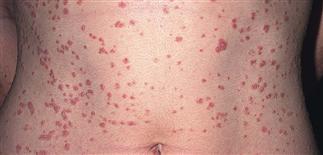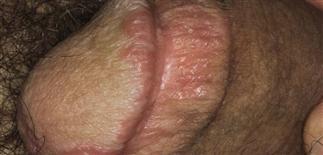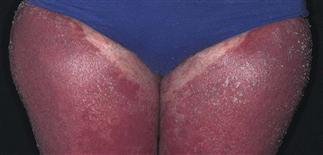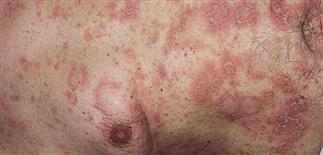39
Psoriasis: special forms

Guttate psoriasis. Numerous, generalized papules may abruptly occur following streptococcal pharyngitis.

Guttate psoriasis. Papules are 0.5–1 cm, red, and covered with typical psoriatic silvery scale.

Erythrodermic psoriasis. This form is usually generalized with minimal scale. Erythema is intense and the patient loses body heat.

Pustular psoriasis. Numerous pustules arise from a red base. The wave of scale appears as the pustules evolve and expands outward.
DESCRIPTION
Chronic, inflammatory disease due to abnormal T-lymphocyte function. Affects skin, scalp, joints, nails.
HISTORY
• Chronic course; exacerbations, remissions. • Genetic predisposition with environmental triggers, including stress, physical trauma, Streptococcus infections, drugs (lithium, beta-blockers, antimalarials, corticosteroid withdrawal), HIV. • Nail involvement: 10–50%. • Psoriatic arthritis (rheumatoid factor-negative): 7–20%. May precede skin disease.
PHYSICAL FINDINGS
Most common: chronic plaque psoriasis. Extent highly variable. Other presentations below. • Guttate. Common presentation in children; follows group A streptococcal pharyngitis. Sudden appearance of 0.3- to 1.0-cm papules primarily on trunk, extremities. Spares palms, soles. • Pustular. Rare, severe, unstable. Sterile pustules arise on red base and coalesce, forming pus lakes. Erythema progresses in waves; patient may appear toxic with fever and skin pain. Generalized forms serious, potentially fatal. Oral steroid withdrawal may precipitate. • Erythrodermic. Uncommon. May be initial presentation or evolve from chronic plaque disease. Localized progressing to generalized erythema with little scale. Oral steroid administration or withdrawal may precipitate. May appear toxic (chills and skin pain). • Pustular psoriasis of palms and soles. Chronic, recurrent, treatment-resistant. Sterile pustules evolve from red base on palms, instep. Pustules do not rupture but turn dark brown and scaly. Often painful, limiting mobility. • Scalp psoriasis. Common. Scale may be very thick, anchored by hair. Plaque may extend beyond hairline. Itching varies. • Intertriginous (inverse). Flexural or intertriginous areas: gluteal fold, axillae, under breasts, groin. Smooth, red, sharply defined plaques with macerated surface. Superimposed Candida infection in diabetic patients, with topical steroid use.
TREATMENT
Similar to that for chronic plaque psoriasis, with specific considerations. • Guttate psoriasis. Treat streptococcal infection with penicillin or equivalent. Skin lesions best treated with triamcinolone 0.1% cream b.i.d. with addition of ultraviolet B therapy. • Pustular psoriasis. Requires specialist care by dermatologist. Pustular flares respond to Neoral or Soriatane. Ultraviolet B and psoralen plus ultraviolet A useful adjunctive therapies. • Erythrodermic psoriasis. Best managed with Neoral, Soriatane, or methotrexate. Ultraviolet therapy and topical steroids helpful adjunctive therapies. • Intertriginous (inverse) psoriasis. Best managed with lower-potency group V topical steroids to minimize atrophy risk. Use in cycles (e.g. b.i.d. for 10–14 days, stop of 10–14 days). • Scalp psoriasis. Treatment with tar (T-Gel, etc.) or salicylic acid shampoos removes some scale. Diffuse scale: apply Derma-Smooth FS oil to scalp at bedtime, cover with shower cap. Steroid gels (e.g. Lidex, Temovate, Topicort), steroid foams (Olux, Luxiq), or solutions (Cormax) penetrate through hair into scale. Dovonex solution 60 cc b.i.d. on weekdays as tolerated. Taclonex solution q.d.







